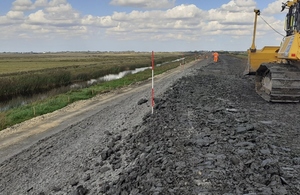Flood protection project continues on the Ouse Washes
Further year of work ahead as the scheme to raise the banks of the Ouse Washes flood storage reservoir continues.

Works to raise the banks of the Ouse Washes
The project to raise the Middle Level Barrier Bank to improve the Ouse Washes flood storage reservoir will maintain the standard of flood protection to more than 2,000 properties and 67,000 hectares of agricultural land.
As the washes are an internationally important habitat, construction work will continue during summer and early autumn to avoid disturbing breeding and over-wintering birds.
The improvement works underway will ensure compliance with recommendations made by the reservoir inspecting engineer. As such, it has a statutory deadline for completion under the Reservoirs Act 1975.
A reservoir inspection in 2020 set deadlines for the project with the physical construction to be completed by December 2022. Following this, there will be a further 2 years of maintenance works to establish grass cover to ensure the stability of the banks.
Demountable flood barrier at Welney
As part of the project and to comply with the Reservoirs Act, a robust demountable flood barrier is required at Welney where the Wash Road meets the Middle Level Barrier Bank.
Originally planned to take place during 2021, this work has been rescheduled for 2022. This is due to delays last year in the bank raising work caused by wet weather.
To complete the flood barrier construction it will be necessary to gain permission to close the Welney Wash Road/A1101 for 6 to 8 weeks in 2022.
A consultation with residents indicates that their preferred time for these works to be carried out is during the school summer holidays. See the report to the consultation.
Nicola Oldfield, Project Manager for the Environment Agency, said:
The construction works to refurbish the Ouse Washes flood storage reservoir remain on track to be completed by the end of 2022.
We are complying with recommendations from the reservoir inspecting engineer. The work when finished will help to ensure that people, land and buildings are protected from flood water escaping from the reservoir for years to come. The public can be assured that the reservoir remains in a safe condition while these works are ongoing.
We would like to thank the local community for their patience and understanding during this challenging complex programme of work which is taking longer than we originally predicted.
The work is being carried out in line with the government’s coronavirus guidance with public footpaths along the crest of the Middle Level Barrier Bank diverted to maintain safety.
Further information on the project is available on the Ouse Washes Citizen Space information page.
Further information
The Ouse Washes flood storage reservoir is located on the River Great Ouse north east of Huntingdon in the Environment Agency’s Cambridgeshire and Bedfordshire Area. It is registered under the Reservoirs Act 1975 and the Environment Agency is the Undertaker for the reservoir.
The flood storage reservoir is approximately 30 kilometres long, varies in width between 200 metres and 800 metres and covers an area of approximately 1,900 hectares.
The Middle Level Barrier Bank and the Cradge Bank form the 2 dams of the reservoir; both are approximately 30 kilometres long and have a maximum height of 5 metres. When the water level in the reservoir reaches the Cradge Bank’s crest it is storing approximately 90,000,000 cubic metres of water above the surrounding ground.
The Ouse Washes system was originally conceived more than 350 years ago. Its creation played a major role in turning the Fens into agricultural land. The Washes span more than 10 parishes and 2 counties.
As well as being one of the country’s largest flood defence systems, it is an internationally important nature reserve attracting visitors for wildlife and recreation. Its designations include Site of Special Scientific Interest (SSSI), Special Protection Area (SPA), Special Area of Conservation (SAC) and a Ramsar wetland site.
As the washes are an internationally-important habitat, the work has to take place in the summer and early autumn to avoid disturbing breeding and over-wintering birds.